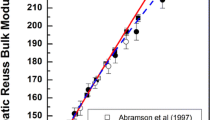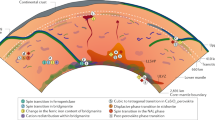Abstract
Using in situ strength measurements at pressures up to 10 GPa and at room temperature, 400, 600, and 700°C, we examined rheological properties of olivine, orthopyroxene, and chromian-spinel contained in a mantle-derived xenolith. Mineral strengths were estimated using widths of X-ray diffraction peaks as a function of pressure, temperature, and time. Differential stresses of all minerals increase with increasing pressure, but they decrease with increasing temperature because of elastic strain on compression and stress relaxation during heating. During compression at room temperature, all minerals deform plastically at differential stress of 4–6 GPa. During subsequent heating, thermally induced yielding is observed in olivine at 600°C. Neither orthopyroxene nor spinel shows complete stress relaxation, but both retain some stress even at 700°C. The strength of the minerals decreases in the order of chromian-spinel ≈ orthopyroxene > olivine for these conditions. This order of strength is consistent with the residual pressure of fluid inclusions in mantle xenoliths.







Similar content being viewed by others
References
Anderson OL, Isaak DG (1995) Elastic constants of mantle minerals at high temperature. In: Ahrens TJ (ed) Mineral Physics & Crystallography, AGU Reference Shelf 2, pp 64–97
Andersen T, Neumann E-R (2001) Fluid inclusions in mantle xenoliths. Lithos 55:301–320
Bass JD (1995) Elasticity of minerals, glasses and melts In: Ahrens TJ (ed) Mineral Physics & Crystallography, AGU Reference Shelf 2, pp 45–63
Chen J, Inoue T, Weidner DJ et al (1998) Strength and water weakening of mantle minerals, olivine, wadsleyite and ringwoodite. Geophys Res Lett 25:575–578
Chen J, Weidner DJ, Vaughan MT (2002) The strength of Mg0.9Fe0.1SiO3 perovskite at high pressure and temperature. Nature 419:824–826
Decker DL (1971) High-pressure equation of state for NaCl, KCl and CsCl. J Appl Phys 42:3239–3244
De Vivo B, Frezzotti ML, Lima A et al (1988) Spinel lherzolite nodules from Oahu Island (Hawaii): a fluid inclusion study. Bull Mineral 111:307–319
Frezzotti ML, Burke EAJ, DeVivo B et al (1992) Mantle fluids in pyroxenite nodules from Salt Lake Crater (Oahu, Hawaii). Eur J Mineral 4:1137–1153
Gerward L, Morup S, Topsoe H (1976) Particle size and strain broadening in energy-dispersive X-ray powder patterns. J App Phys 47:822–825
Green HW, Borch RS (1987) The pressure dependence of creep. Acta Metall 35:1301–1315
Hirano N, Yamamoto J, Kagi H et al (2004) Young olivine xenocryst-bearing alkali-basalt from the oceanward slope of the Japan Trench. Contrib Mineral Petrol 148:47–54
Hirth G, Kohlstedt D (2003) Rheology of the upper mantle and the mantle wedge: a view from the experimentalists. In: Eiler J (ed) Inside the subduction factory, J AGU Geophys Monogr 138:83–105
Irifune T (2002) Application of synchrotron radiation and Kawai-type apparatus to various studies in high-pressure mineral physics. Min Mag 66:769–790
Karato S-I, Wu P (1993) Rheology of the upper mantle a synthesis. Science 260:771–778
Karato S, Jung H (2003) Effects of pressure on high-temperature dislocation creep in olivine. Philos Mag 83:401–414
Kohlstedt DL, Wang Z (2001) Grain-boundary sliding accommodated dislocation creep in dunite. EOS Trans AGU 82:F1137
Kohlstedt DL, Goetze C, Durham WB et al (1975) A new technique for decorating dislocations in olivine. Science 191:1045–1046
Kung J, Li B, Uchida T et al (2004) In situ measurements of sound velocities and densities across the orthopyroxene—high-pressure clinopyroxene transition in MgSiO3 at high pressure. Phys Earth Planet Int 147:27–44
Li L, Weidner D, Raterron P et al (2004) Stress measurements of deforming olivine at high pressure. Phys Earth Planet Int 143–144:357–367
Li L, Weidner D, Raterron P et al (2006) Deformation of olivine at mantle pressure using D-DIA. Eur J Mineral 18:7–19
Li L, Addad A, Weidner D et al (2007) High pressure deformation in two-phase aggregates. Tectonophysics 439:107–117
Mackwell SJ (1991) High-temperature rheology of enstatite: implications for creep in the mantle. Geophys Res Lett 18:2027–2030
Mitchell TE, Hwang L, Heuer AH (1976) Deformation in spinel. J Material Sci 11:264–272
Raterron P, Wu Y, Weidner DJ et al (2004) Low-temperature olivine rheology at high pressure. Phys Earth Planet Int 145:149–159
Roedder E (1965) Liquid CO2 inclusions in olivine-bearing nodules and phenocrysts from basalts. Am Mineral 50:1746–1782
Ross JV, Ave Lallemant HG, Carter NL (1979) Activation volume for creep in the upper mantle. Science 203:261–263
Sapienza G, Hilton DR, Scribano V (2005) Helium isotopes in peridotite mineral phases from Hyblean Plateau xenoliths (southeastern Sicily, Italy). Chem Geol 219:115–129
Sawaguchi T, Ishii K (2003) Three-dimensional numerical modeling of lattice- and shape-preferred orientation of orthopyroxene porphyroclasts in peridotites. J Struct Geol 25:1425–1444
Saxena SK, Chatterjee N, Fei Y et al (1993) Thermodynamic data on oxides and silicates. Springer, New York
Schwab RG, Freisleben B (1988) Fluid CO2 inclusions in olivine and pyroxene and their behaviour under high pressure and temperature conditions. Bull Mineral 111:297–306
Ulmer P, Stalder R (2001) The Mg(Fe)SiO3 orthoenstatite-clinoenstatite transitions at high pressures and temperatures determined by Raman-spectroscopy on quenched samples. Am Mineral 86:1267–1274
Utsumi W, Funakoshi K, Urakawa S et al (1998) SPring-8 beamlines for high pressure science with multi-anvil apparatus. Rev High Pressure Sci Technol 7:1484–1486
Weidner DJ (1998) Rheological studies at high pressure. In: Hemley RJ, Mao HK (eds) Ultrahigh-pressure mineralogy: physics and chemistry of the earth’s deep interior. Mineralogical Society of America, Washington, DC, pp 493–524
Weidner DJ, Wang Y, Vaughan MT (1994) Yield strength at high pressure and temperature. Geophys Res Lett 21:753–756
Weidner DJ, Wang Y, Chen G et al (1998) Rheology measurements at high pressure and temperature. Geophys Monogr 101:473–482
Weidner DJ, Chen J, Xu Y et al (2001) Subduction zone rheology. Phys Earth Planet Int 127:67–81
Wells PRA (1977) Pyroxene thermometry in simple and complex systems. Contrib Mineral Petrol 62:129–139
Yamamoto J, Kagi H, Kaneoka I et al (2002) Fossil pressures of fluid inclusions in mantle xenoliths exhibiting rheology of mantle minerals: implications for the geobarometry of mantle minerals using micro Raman spectroscopy. Earth Planet Sci Lett 198:511–519
Yamamoto J, Kaneoka I, Nakai S et al (2004) Evidence for subduction-related components in the subcontinental mantle from low 3He/4He and 40Ar/36Ar ratio in mantle xenoliths from Far Eastern Russia. Chem Geol 207:237–259
Yamamoto J, Kagi H, Kawakami Y et al (2007) Paleo-Moho depth determined from the pressure of CO2 fluid inclusions: Raman spectroscopic barometry of mantle- and crust-derived rocks. Earth Planet Sci Lett 253:369–377
Zhang J, Wang L, Weidner DJ et al (2002) The strength of moissanite. Am Mineral 87:1005–1008
Acknowledgments
Drs. Matsui M., Nishihara Y. and an anonymous reviewer provided thoughtful comments to improve the manuscript. We appreciate Y. Higo, F. Kurio, T. Sanehira, Y. Sueda and colleagues at Ehime University for their help in creating the pressure cell. This study was supported by a Grant-in-aid for the twenty-first Century COE Program for KAGI21 (Kyoto University, G3) and for Frontiers in Fundamental Chemistry, and by Grants-in-aid for Scientific Research (Nos. 13554018, 14654096, 15340190, 18740344 and 19GS0205) from the Japan Society for the Promotion of Science (JSPS) and JSPS Postdoctoral Fellowships for Research Abroad.
Author information
Authors and Affiliations
Corresponding author
Rights and permissions
About this article
Cite this article
Yamamoto, J., Ando, Ji., Kagi, H. et al. In situ strength measurements on natural upper-mantle minerals. Phys Chem Minerals 35, 249–257 (2008). https://doi.org/10.1007/s00269-008-0218-6
Received:
Accepted:
Published:
Issue Date:
DOI: https://doi.org/10.1007/s00269-008-0218-6




